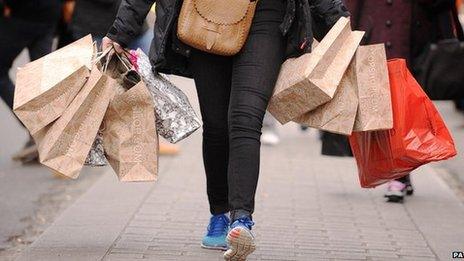Online shops take stock and move into the High Street
- Published

We're definitely a nation of shoppers. We spent more than £311bn shopping last year, but how we like to shop remains the same - 90% of that money was spent in actual shops and stores.
Figures like that may come as a surprise, because over the past year more and more has been written about the High Street's inevitable decline.
But the value of having a physical branch for people to visit should not be underestimated.
A recent survey from retail analysts Kantar found that 70% of us like to touch a product before we buy it.
Shopping is a social activity and, despite the bargains to be found online, most people would still like to run their fingers along a clothes rail or fiddle with gadgets before they hand over their cash.
It is a mantra that has been heeded by a clutch of successful retailers over recent years.
Trying before you buy
Screwfix started out as a catalogue retailer in 1979, and its listings of nuts, bolts and nails were the cornerstone of any tradesman's toolkit, but in 2005, after the business was bought out by the retail giant Kingfisher, Screwfix made the move from paper to bricks and mortar.
It now has almost 300 stores across the UK.
"We had tradesmen turning up at our main warehouse in Somerset asking for things that day - our next-day delivery service was not soon enough," says chief executive Andrew Livingstone.
Such is the urgency for a Screwfix fix that he says they now have people sitting in their cars outside stores, ordering items through its click-and-collect service and then popping into the store to collect them moments later.
As any tradesman will tell you, there's no room for error in the building industry, so it makes sense that being able to try out a product before you drill, hammer or cement it into your home is important.
But the same applies to little luxuries.
Price remains king
Oak Furniture Land started life as an eBay retailer in 2003 but within just a few years it had become the auction site's biggest retailer and was setting up its own website.
Soon that was not enough, and it has since started opening stores across the UK to keep up with demand.
Managing director Jason Bannister said it was a natural transition.
"So long as quality furniture looks good, it fills people's needs - which is why the internet worked for us.
"But with it being furniture, and going into people's homes, there is a big appetite to touch it and look at it, too."
Oak Furniture Land now does 65% of its trade in-store - and that has boosted its turnover considerably.
But with a store come rent, taxes, utility bills and, of course, staff.
In the world of retail, price remains king; more than two-thirds of us will shop online to get the best price, according to Kantar.
Striking a balance between having a nice store to visit and keeping your costs low is crucial.
"The stores are far more expensive, but the internet doesn't come without cost - you need to staff sales and service centres, too," says Mr Bannister.
"But we don't have to have a lot of staff, as most people know what they want and we get some great deals on rent at retail parks."
The challenge of 'showrooming'
Perhaps the biggest lure of the High Street is the experience. Going to the shops is a social habit that people do together. This has been recognised at online fashion group JD Williams.
"We opened seven SimplyBe stores last year, and now there is the male version, Jacamo, in five of them, dual-fascia stores like Topshop and Topman," says director Paul Kendrick.
"We know that a large chunk of our customers still love their High Street. We also know that many husbands and wives, or boyfriends and girlfriends, like to shop together.
"Doing it this way makes a lot of sense."
It is early days on the street for these brands, but Mr Kendrick says he cannot imagine Britain without shops to visit. It is part of everyone's Saturday afternoon.
However, many bricks-and-mortar stores are falling victim to "showrooming", where consumers go in, play with the product they want, and then buy it more cheaply from an online retailer.
It is a phenomenon said to be part of the demise last year of Jessops and Comet, and a survey by agency Foolproof found that 24% of us admitted to doing it in the run-up to last Christmas.
Another major criticism of High Street retailers is overexpansion.
Andrew Livingstone said Screwfix was aware of hitting critical mass with its stores: "We're still feeling our way, we are still growing, but we want to keep the same very simple model."
It is worth remembering that although more than 15,000 independent shops opened last year, the same number also closed down.
Still - smaller, leaner, with a hefty website to back them up - the successful retailers of the future could prove there's life in the old High Street yet.